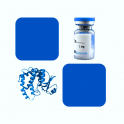
- Remove this product from my favorite's list.
- Add this product to my list of favorites.
Products
Viewed products
Newsletter
 |  |  |  |  |  |

Background
E-Selectin, also known as CD62 antigen-like family member E (CD62E), endothelial-leukocyte adhesion molecule 1 (ELAM-1), or leukocyte-endothelial cell adhesion molecule 2 (LECAM2), a member of the Selectin family, is a 107-115 kDa cell surface glycoprotein.[1] It is transiently expressed on vascular endothelial cells in response to IL-1β and TNFα. E selectin has a cassette structure: an N-terminal, C-type lectin domain, an EGF (epidermal-growth-factor)-like domain, 6 Sushi domain (SCR repeat) units, a transmembrane domain (TM) and an intracellular cytoplasmic tail (cyto).[2] During inflammation, E-selectin plays an important part in recruiting leukocytes to the site of injury. The local release of cytokines IL-1 and TNF-α by damaged cells induces the over-expression of E-selectin on endothelial cells of nearby blood vessels.[3] E-selectin mediates the adhesion of tumor cells to endothelial cells, by binding to E-selectin ligands expressed by neutrophils, monocytes, eosinophils, memory-effector T-like lymphocytes, natural killer cells or cancer cells. Furthermore, a number of studies have reported that levels of E-Selectin may be elevated in subjects with a variety of pathological conditions.
Source
Recombinant Human CD62E /E-Selectin Protein, Fc Tag (CDE-H5250) is expressed from human 293 cells (HEK293). It contains AA Trp 22 - Phe 556 (Accession # NP_000441.2).
Predicted N-terminus: Trp 22
Molecular Characterization
This protein carries a human IgG1 Fc tag at the C-terminus.
The protein has a calculated MW of 84.8 kDa. The protein migrates as 110-140 kDa under reducing (R) condition (SDS-PAGE) due to glycosylation.
Endotoxin
Less than 1.0 EU per μg by the LAL method.
Purity
>90% as determined by SDS-PAGE.
Formulation
Lyophilized from 0.22 μm filtered solution in Tris with Glycine, Arginine and NaCl, pH7.5 with trehalose as protectant.
Reconstitution
See Certificate of Analysis for details of reconstitution instruction and specific concentration.
Storage
For long term storage, the product should be stored at lyophilized state at -20°C or lower.
Please avoid repeated freeze-thaw cycles.
This product is stable after storage at:
-20°C to -70°C for 12 months in lyophilized state;
-70°C for 3 months under sterile conditions after reconstitution.
(1) "The effect of exercise on blood concentrations of angiogenesis markers in older adults: A systematic review and meta-analysis"
Song, Azhar, Koo et al
Neurobiol Aging (2023) 135, 15-25
(2) "Sialyl LewisX glycomimetics bearing an extended anionic chain targeting E- and P- selectin binding sites"
Belouin, Simard, Joyal et al
Bioorg Med Chem (2023) 98, 117553
(3) "Retraction Note: Valproic acid attenuates intercellular adhesion molecule-1 and E-selectin through a chemokine ligand 5 dependent mechanism and subarachnoid hemorrhage induced vasospasm in a rat model"
Chang, Wu, Lin et al
J Inflamm (Lond) (2023) 20 (1), 45
Showing 1-3 of 9713 papers.
Follow us